Leonardo Da Vinci - Inventions of Flight
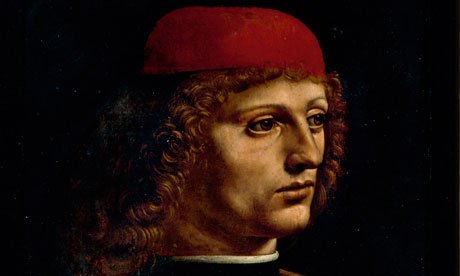
When I think about the human geniuses of history, one name that always comes to mind is the great Leonardo Da Vinci. Artist, Inventor, Cartographer, Engineer, Architect, Musician, Writer, Biologist, Botanist and Mathematician - he left his mark on everything he did.
Born out of wedlock on April 15, 1452 in the village of Vinci, located in the Tuscany region of Italy. His father, 25 year old Messer Piero Fruosino di Antonio da Vinci, was a Florentine legal notary. His mother was a commoner woman named Caterina from the nearby hamlet of Anchiano, she raised him until the age of 5 when he was given over to his father, Ser Piero.
The title of “Ser” or Sir indicates that Leonardo’s father was a gentleman. Ser Piero married 4 times in his life, his first two wives dying very young and without children, but his next two wives each bore him 6 children. Leonardo didn’t speak with his brothers and sisters too often as they were much younger than him (the last one being born when he was 40 years old), and only seemed to cause him problems during the inheritance of his father’s estate.
His mother stayed in Anchiano and married a local artist named Accattabriga. She had five more children, bringing the total half brothers and sisters of Leonardo to 17.
Growing up in his father’s home with his grandparents and uncles gave Leo access to some scholarly books owned by the family and by his father’s friends. Because Leo was illegitimate, he was unable to follow in the footsteps of his father to become a notary and was also barred from attending the schools of the day. Free of that burden, he was left to develop into the man he was to become. Although his father was able to secure him a basic education from a local priest who taught Leo reading (Latin), writing, and mathematics.
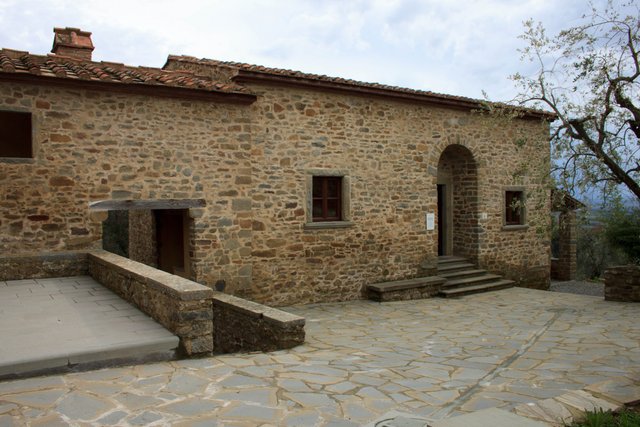
He would spend his other days with his uncle Francesco, a farmer. He would tend the fields and the animals, and observe all that nature offered. In his own words ”I roamed the countryside searching for the answers to things I did not understand. Why shells existed on the tops of mountains along with the imprints of coral and plant and seaweed usually found in the sea. Why the thunder lasts a longer time than that which causes it and why immediately on its creation the lightening becomes visible to the eye while thunder requires time to travel. How the various circles of water form around the spot which has been struck by a stone and why a bird sustains itself in the air. These questions and other strange phenomena engaged my thought throughout my life.”
Starting at a very young age Leonardo was fascinated by birds, which continued throughout his life. He was known to purchase birds in the marketplace, study their wings, and then let them go to study the action of flight. When he was 53 he stated he became interested in birds and flight “because in the earliest memory of my childhood it seemed to me that as I lay in my cradle a kite(a hawk with long tail feathers) came down to me and opened my mouth with its tail and struck me with its tail many times between the lips.” If he could truly remember being in his cradle, it would seem that he had a memory that began extraordinarily early in life.
INVENTIONS OF FLIGHT
PARACHUTE (Codex Atlanticus)
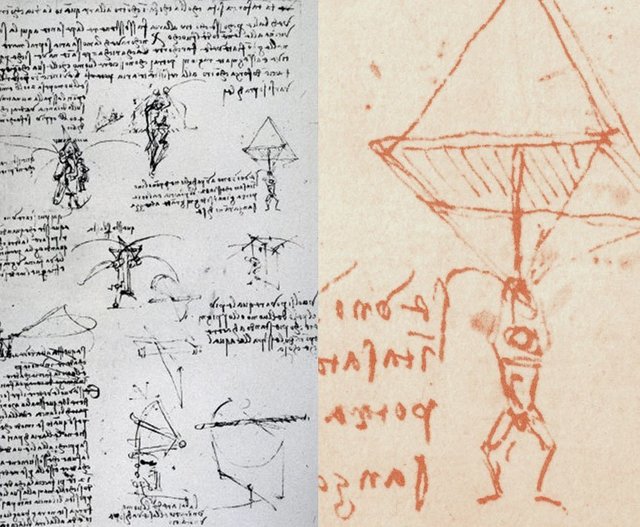
In 1485 it has been said that Leonardo was commissioned to design a device that a wealthy patron could use to escape from a high tower. What he came up with is a pyramid shaped cone of linen wrapped around a wooden structure and rope for the person to hold onto.
Leonardo writes "If a man have a tent made of linen of which the apertures (openings) have all been stopped up, and it be twelve braccia (7.2 meters or 23 feet) across and twelve in depth, he will be able to throw himself down from any great height without suffering any injury."
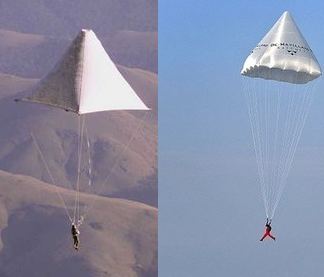
Skeptics of this design said that it wouldn’t have enough resistance to arrest the fall and lacked a hole at the top to stabilize it. In 2000, Adrian Nichols silenced the critics by successfully jumping from a hot air balloon at 3,000 meters using the design and materials instructed by Da Vinci. He said the ride down was smoother than modern parachutes and the only danger was that it weighed 187 pounds, so he had to be careful it didn’t hit him upon landing. In 2008, Olivier Vietti-Teppa used modern materials but Leonardo’s design to jump out of an aircraft and land safely on the ground.
ORNITHOPTERS (Codex Atlanticus)
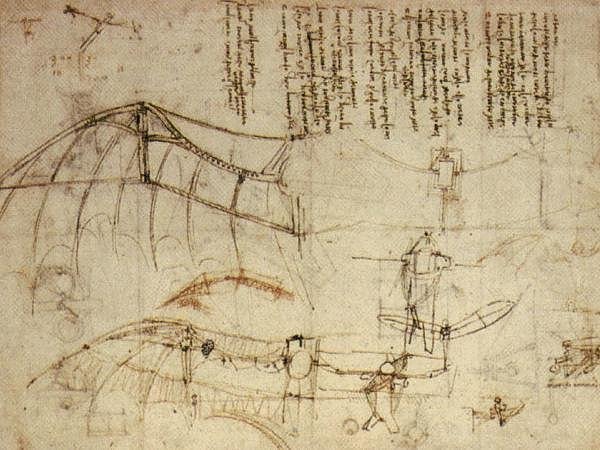
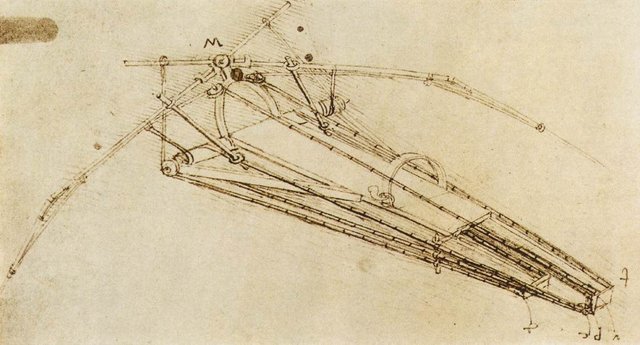
Da Vinci’s first attempt to bring man to the skies was the ornithopter, a creation that requires wing-flapping to achieve flight. He designed several from 1486-1490, and in some ways it was his attempt at a mechanical version of the way birds and bats fly. Leonardo realized that humans are too heavy and not strong enough to fly using arm power alone, so in 1487 he designed one craft in which the pilot lies down and works the wings using hand levers, foot pedals, and pulleys. This method comes close to the optimizing the maximum energy possible from a human being.
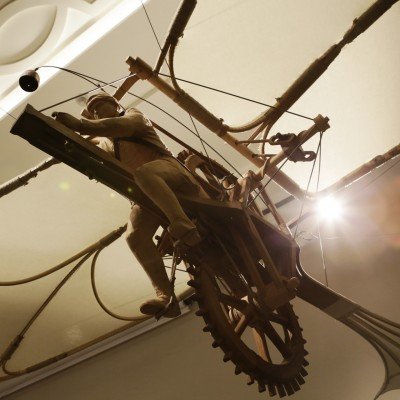
Another version from 1487, called the flying bicycle ornithopter. The pilot would pedal (one foot straight down, one foot straight up) as hard as possible to operate a system of gears and pulleys to flap the wings, the hands would operate levers to assist in wing flapping and to control the flight. This design has a bell in front of the pilots head that would show him how level his flight was, as the clapper would touch if not. It was the first attitude indicator ever designed. It just shows how far thinking he was.
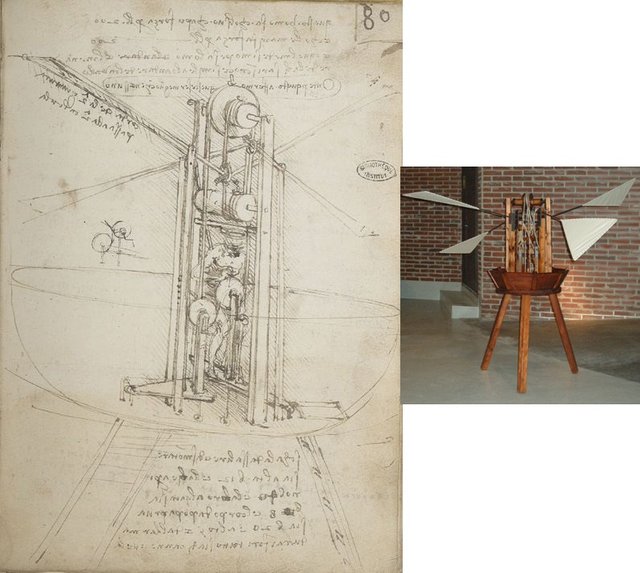
The other complex ornithopter, this one was sketched in his Paris Manuscript B was designed around 1488-1490, in addition to using his arms and legs to rapidly operate the wings, the pilot had to wear a head harness to control the rudder/elevator combination. Certainly a good workout, but not able to be powered into flight by any human alone. This design is noteworthy for the simple retractable landing gear beneath the craft, operated by pulling or dropping a rope.
It was stated that the structures be made of pine with cotton sail cloth for the wings. There is no evidence that Leonardo actually attempted to build these creations, but he did state to test them over a lake first, for safety. However, in 1550 it is said that one of Da Vinci’s associates, Cardanus, tried “in vain” to get one of the vehicles off the ground.
HELICOPTER (Paris Manuscript B)
Or the Aerial Screw, designed around 1489-1493 it was based off of a children’s toy from Asia invented around 1320 or possibly from a maple seed, as the trees are found in northern Italy. It was designed to achieve lift by compressing air, as the helicopters of today do.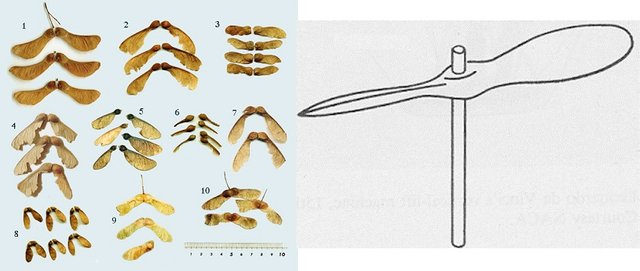
This craft was to be made of reed (bamboo) along with pine, linen, and wire. Da Vinci stated “The external edge of the aerial screw is a thick wire with a maximum radius of about four meters (13 feet). To make this instrument correctly, you would need to use starched-linen cloth so the air does not pass through. If it is rotated quickly, this machine will spin as though it were a screw that penetrates the air and it will rise. To understand how this is possible, hold a drawing ruler in your hand and move it quickly sideways in the air, and you will feel how the ruler is pushed in the direction of the edge, going up or down”.
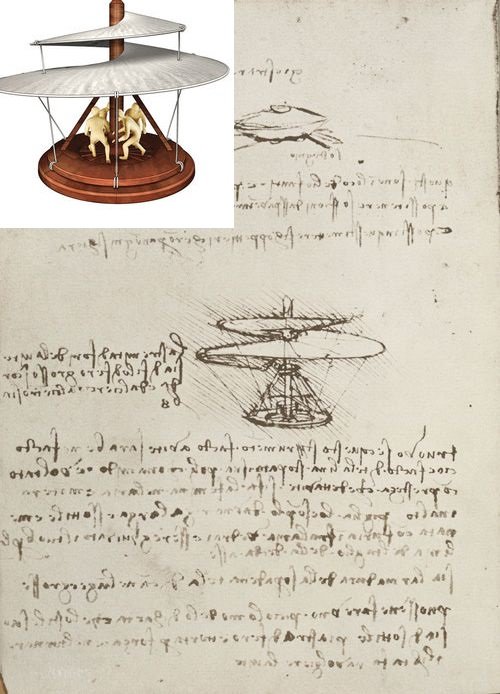
It was sketched to be powered by 4 people pushing a bar that would cause the central spiral to turn, though the low power to weight ratio of this machine would never have allowed it into the air. He might not have realized that even if it did get in the air the forward motion of the pushers would just cause the floor to move backwards, negating the effort. However, it is an achievement of theory and imagination well ahead of its time. There is no evidence that this was ever built.
GLIDERS (Codex Madrid I)
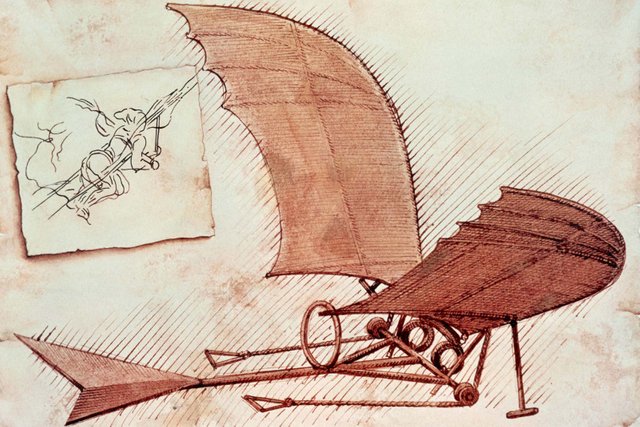
Two main versions of a glider can be found in his works. The first one was a glider with movable wings, the idea was that the pilot would lay with his waist inside the ring, his feet in the stirrups to assist the force of his hands in holding the two wing levers. Interestingly, this design included a tail. Control was to be obtained by angling of the arms/wings in his papers he wrote "this [man] will move on the right side if he bends the right arm and extends the left arm; and he will then move from right to left by changing the position of the arms."
Da Vinci’s initial idea of lift was incorrect, he thought that high pressure was created under the wing causing lift. Later on he discovered that lift was caused by low pressure on top of the wing, in which he concluded that flight could be achieved with fixed wings. It was during this research he also found what is known as drag, the resistance something incurs when passing through the air and that it could be reduced by streamlining the body. These things were not rediscovered until 1809 by Sir George Cayley.
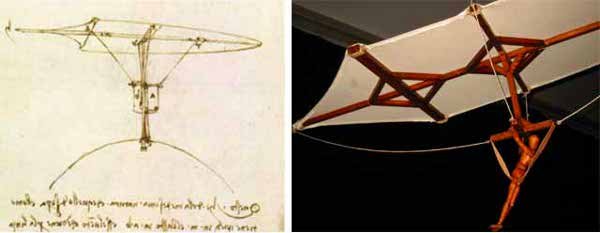
The second glider was created sometime less than 10 years before his death in 1519, in this one Leonardo did away with movable and flapping wings for good. It closely resembles the hang gliders of today. The pilot would stand upright and control the aircraft using cords and the long curved pole along the bottom, presumably like a rudder, swing it from side to side as needed. Some of his ornithopters had tails and in 1505 he wrote of the importance of a bird’s tail in flight, so it is possible that he intentionally left out the tail and how to control the craft to protect his ideas.
A modified version of the Da Vinci design was successfully flown in Wiltshire in November 2002 by Robbie Whittall. A tail was added and flight controls were replaced with contemporary glider A-frame. Leonardo’s glider would have worked without these modifications, only that the flight would have been far less controllable.
Robbie commented, “It was a privilege to fly the glider and although our model was not a perfect representation of Leonardo’s idea, it proved to me that he was most definitely thinking on the right lines. It has more than proved to me that his direction and imagination could have had man flying 500 years ago!”
One of my favourite movies : two friends go back in the past and meet Leonardo
http://www.dailymotion.com/video/x2yg286
At the end of the movie Leonardo builds a steam train.
Thanks for this, I loved it! I have never seen the film before.
Yes, it's an italian movie, very good indeed
Yes, think that's the helicopter one. didn't realize even parachute.
Yes, pretty amazing the things he thought of way back then. I hope you will be here to read my next few parts about anatomy and water inventions and all that stuff.
I just got on the train if you know what I mean. :-)
nice work bro!
Thank you very much! Second in the series will be posted soon.
Great post, so much may be written on the genius of Leonardo, so I think you have still many posts to be written.
Following you for more about that :)
Thank you, the next article will be posted in a few hours. :D
I am sorry I only can give you one up-vote. Leonardo is one of my favorite painters and, in general, the most adored person in history. It's too bad that for some people the name Leonardo only means one of the Ninja Turtles.
A long time ago I watched an Italian movie about him and up to now remember one great scene where he argued with Michelangelo about a blob of marble, which later on became Michelangelo's David. Please continue posting. I think eventually your posts will find the right people.
I'm sure people will read this in time. There are many more tales to tell of Leonardo!
Leonardo Da Vinci was one of the pioneers of our age and led to so many great inventions that we all take for granted today.
Beautifully written insight into the mans life with perfect detail in your explanations. Absolutely killer job! :)
He was quite remarkable, and the more I delve into his life the more I discover about him. I am looking forward to writing up my future posts, even if the information is scattered all over the internet! I think I had at least 20 tabs open to research this one.
Fascinating stuff. Thanks @getonthetrain!
Thanks @anotherjoe , I would have left a comment on your latest Happy Dog, but I had no questions this time!
Haha, no questions? That's great. I must have made sense this time! :D
Thanks for this nice piece of history :)
Your kind words are much appreciated! :)